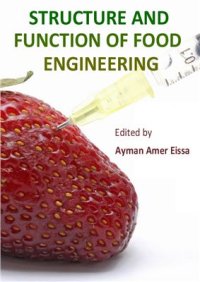
Ebook: Structure and Function of Food Engineering
Author: Eissa A.A.(Ed.)
- Genre: Technique // Food Manufacturing
- Tags: Пищевая промышленность, Пищевая биотехнология
- Language: English
- pdf
InTeOp, 2012. — 413 p.ISBN: 9535106951 9789535106951.This book conveys many significant messages for the food engineering and allied professions: the importance of working in multidisciplinary teams, the relevance of developing food engineering based on well-established principles, the benefits of developing the field by bringing together experts from industry, academia and government, and the unparalleled advantage of working as globally as possible in the understanding, development, and applications of food engineering principles.Contents:
Characteristics of Foods.
Antioxidant, Anticancer Activity, and Other Health Effects of a Nutritional Supplement (Galaxy(r)).
Oxygen Scavengers: An Approach on Food Preservation.
Protein-Based Edible Films: Characteristics and Improvement of Properties.
Staphylococcus aureus: Characterisation and Quantitative Growth Description in Milk and Artisanal Raw Milk Cheese Production.
Rice Starch-Based Biodegradable Films: Properties Enhancement.
Foodborne Botulism Poisoning.
Botulinum Toxin Complex: A Delivery Vehicle of Botulinum Neurotoxin Traveling Digestive Tract.
Climate Change: Implication for Food-Borne Diseases (Salmonella and Food Poisoning Among Humans in R. Macedonia).
Mycotoxin Decontamination Aspects in Food. Feed and Renewables Using Fermentation Processes.
Possible Risks in Caucasians by Consumption of Isoflavones Extracts Based.
Food Processing Technology.
Understanding Color Image Processing by Machine Vision for Biological Materials.
Pulsed Electric Fields for Food Processing Technology.
Public Health Policies and Functional Property Claims for Food in Brazil.
Molecular Basis of Physiological Responses.
The Emerging Role of the Yeast Torulaspora delbrueckii in Bread and Wine Production: Using Genetic Manipulation to Study Molecular Basis of Physiological Responses.
Nucleic Acid-Based Methods to Identify. Detect and Type Pathogenic Bacteria Occurring in Milk and Dairy Products.
Characteristics of Foods.
Antioxidant, Anticancer Activity, and Other Health Effects of a Nutritional Supplement (Galaxy(r)).
Oxygen Scavengers: An Approach on Food Preservation.
Protein-Based Edible Films: Characteristics and Improvement of Properties.
Staphylococcus aureus: Characterisation and Quantitative Growth Description in Milk and Artisanal Raw Milk Cheese Production.
Rice Starch-Based Biodegradable Films: Properties Enhancement.
Foodborne Botulism Poisoning.
Botulinum Toxin Complex: A Delivery Vehicle of Botulinum Neurotoxin Traveling Digestive Tract.
Climate Change: Implication for Food-Borne Diseases (Salmonella and Food Poisoning Among Humans in R. Macedonia).
Mycotoxin Decontamination Aspects in Food. Feed and Renewables Using Fermentation Processes.
Possible Risks in Caucasians by Consumption of Isoflavones Extracts Based.
Food Processing Technology.
Understanding Color Image Processing by Machine Vision for Biological Materials.
Pulsed Electric Fields for Food Processing Technology.
Public Health Policies and Functional Property Claims for Food in Brazil.
Molecular Basis of Physiological Responses.
The Emerging Role of the Yeast Torulaspora delbrueckii in Bread and Wine Production: Using Genetic Manipulation to Study Molecular Basis of Physiological Responses.
Nucleic Acid-Based Methods to Identify. Detect and Type Pathogenic Bacteria Occurring in Milk and Dairy Products.
Download the book Structure and Function of Food Engineering for free or read online
Continue reading on any device:

Last viewed books
Related books
{related-news}
Comments (0)